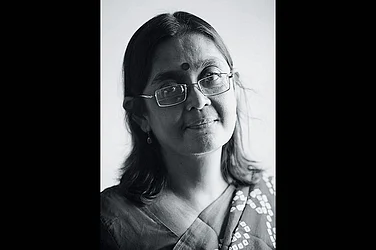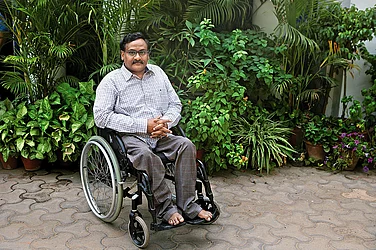In December 2023, on the 22nd anniversary of the militant attack on Parliament, two young men jumped into the Lok Sabha chamber from the visitors’ gallery while two others sprayed yellow gas, almost in sync, and shouted slogans like “tanashahi nahi chalegi” outside the Parliament premises. Their actions, which got them booked under the country’s most stringent anti-terror law, were meant to be a form of protest, albeit unusual, against unemployment. The incident didn’t just expose fault lines in the security system of the then newly-inaugurated building but also the massive problem of joblessness that still persists in the 75-year-old nation.
Their names and pictures made headlines. Sagar Sharma (26), Manoranjan D (34), Amol Shinde (25) and Neelam (42). But behind their actions were stories of India’s educated unemployed—a large section of the youth today.
Youth unemployment has been one of the major talking points in state and central elections. Prime Minister Narendra Modi had promised to create 10 million jobs a year when he came to power in 2014. With the Lok Sabha elections approaching again, the spree of announcements has begun—be it the Congress’ Pehli Naukri Pakki or the BJP’s ‘Modi guarantee’. These promises come in the backdrop of rising joblessness among those in the age group of 20-24, which grew to 44.49 per cent in the October-December 2023 quarter from 43.65 per cent in the July-September 2023 quarter, according to the latest Centre for Monitoring Indian Economy data.
“Election promises look good on paper mostly because they go into oblivion after elections,” says Aratrika, convening body member of the All India Students Association Karnataka and a college student. “Like many other election jumlas, the job promise has been one too,” she says.
Amit Basole, Professor of Economics at Azim Premji University in Bengaluru, says that such announcements of recruitment drives and job reservations indicate the real hunger for government jobs but they are strategically announced before every election cycle.
Nearly two crore young voters, or those aged 18 to 29, will cast ballots for their next government this year. This was the age group that aided Modi’s win in 2019, according to a survey by the Delhi-based Centre for the Study of Developing Societies (CSDS), which revealed that twice as many youths (in this age group) voted for the saffron party as for the Congress—despite unemployment recording new levels that year. They are seen as a demographic that will fuel an economy that Modi says will become the world’s third-largest in the coming years.
Hence, the party targets this age group via social media; addresses them as one of the ‘most important castes’; speaks directly to ‘content creators’ and hands out awards to the best of them. “But usually what happens is that promises are made before the election but after that, the real constraints of the state’s budget come into the picture,” says Basole, adding that either states genuinely don't have the finances to fill the posts or other needs take over. “Respite will only be provided if the government actually follows through and fills the vacant seats,” he says.
Either way, youth have the power to swing the vote share, analysts say. The recently concluded Assembly elections in Telangana were a case in point.
The electoral campaign by the Congress was largely centred on former Chief Minister KCR’s unfulfilled promise of creating jobs. Despite his appeal to the people of the state to vote for the party and the leader who fought relentlessly for a separate state of Telangana, anger among youth and a call for change aided Congress in uprooting the BRS, which had been in power for almost a decade, says Kiran Kumar, a PhD scholar at the University of Hyderabad. “They made promises about creating a job calendar and conducting the much-awaited TSPSC examinations which have been constantly delayed by the BRS government for the last 10 years,” he says. Days after Revanth Reddy took charge as chief minister, he ordered a complete revamp of the state public service commission that conducts exams.
The BJP targets youth—’one of the most important castes’—via social media and hands out awards to the best content creators to woo them.
Despite being one of the most sought-after jobs, not a lot of government job aspirants make the cut. At least 22.05 crore candidates filed applications for jobs in different Central government departments from 2014-15 to 2021-22, but only 0.33 per cent—7.22 lakh—were finally recommended for appointment, according to a written reply given by Jitendra Singh, Minister of State in the Ministry of Personnel, Public Grievances and Pensions, in the Lok Sabha.
For a lot of these aspirants, the damage has already been done. Mahendar, a government job aspirant from Hyderabad, has been looking for a job since 2014. Now over 30, Mahendar is eager to start a family. “But when I can’t earn enough to survive myself, how will I take care of my family?” he asks. “The damage has already been done. We have lost out on a lot of our time.”
Like him, government job aspirants spend most of their adult life seated in dimly-lit rooms in coaching institutions, prepping day and night for competitive exams that might help them land a job. Economists explain that while the increase in education has created aspirations for white-collar, desk jobs, the actual jobs being created for them are low-wage ones, that are not commensurate with their expectations or aspirations.
The State of Working India Report 2023 shows that graduates under 25 years have the highest unemployment rate among all education levels for the same age group. A. Sudhakar (30) has an MSc in Zoology from Hyderabad. He has been trying to apply for a job in the central or state government for the past four years. “Most of us want to get this job due to benefits like job security and financial stability,” he says.
So, he keeps trying and so do lakhs of others. But for Anoop Singh, a college graduate and construction worker in Uttar Pradesh, leaving the country to go work in a war-torn nation was the only option to provide for his family. Governments in Haryana and UP advertised at least 10,000 positions for construction workers in Israel in December 2023. The salary would be around Rs 1,39,115 a month. Singh was one of the thousands waiting at the Lucknow screening centre. “I know there is a threat, but problems exist here too,” Singh told AP, adding that he was willing to take the risk. “I am going there for my children.”
If the job market is so bleak, shouldn’t unemployment be a national problem? ask student activists.
***
At Assi Ghat in Varanasi, a group of students, their parents and some professors gathered for a jan samvad. There was a palpable sense of anger. Professor Chauthi Ram Yadav walked on to the stage, next to which was a picture of Rohith Vemula. “Whether he is alive or not, he attained something great for us. He awakened the students at different universities of the country. As a result, all the students at India’s universities stand today before the nation as an Opposition,” he thundered.
This clip was part of Yousuf Saeed’s 74-minute documentary Campus Rising, which travelled across seven Indian universities where students and some teachers say their freedom is being curtailed. The film was released in 2017, a year after Vemula, a research scholar at the University of Hyderabad, died by suicide in his hostel room due to alleged caste discrimination on campus.
Not much has changed for students from marginalised backgrounds. Payal Tadvi died by suicide in 2019, Darshan Solanki in 2023—both because of alleged caste discrimination on campus. The exact number of student suicides due to caste discrimination is not available with the government.
While these suicides were not directly related to unemployment, student-led organisations have alleged that such instances point towards the larger problem of exclusionary structures in Indian higher education institutions that seep into the job hiring system as well.
The Ambedkar Periyar Phule Study Circle (APPSC), a student-led team in IIT Bombay, that fights back against caste discrimination on campus, obtained data through an RTI in 2022 regarding the representation of SC/STs in faculty recruitments and PhD selections in ‘premier institutions’. The response revealed that five IIMs in 2022 did not admit a single SC candidate and eight IIMs did not admit a single ST candidate in the PhD course. “Scheduled Caste and Scheduled Tribe candidates are deliberately declared “not suitable” for appointment as faculty members in educational institutions because of “biased” assessment by selection panels,” a parliamentary panel noted in February 2024.
While educational institutions continue to deny allegations of discrimination, students say “open flouting of reservation policy, structural casteism, along with exclusionary fee hike and seat cuts all come together to make university spaces more and more inaccessible for students from the already marginalised sections of the society.”
As the primary stakeholders in terms of education and employment, youth-led groups have been making attempts at mobilising others to stand opposed to governments in power and hold them accountable, says Prasanjeet Kumar, a research scholar from UP. AISA, along with other student associations, conducted a survey in over 60 universities across the country in February and came out with their own manifesto titled Young India Manifesto 2024. Privatisation of education, delay in issuing stipends, the decline in funds allocated for the education sector and attempts aimed towards ‘saffronisation’ of education, and stifling of student-led activism were some charges the manifesto listed against the government.
MORE FROM THIS ISSUE
For the next few weeks until the elections begin, Prasanjeet from UP, Aratrika from Karnataka and other student-led groups across the country plan to take these manifestos to the doors of every youth. “The Parliament security breach should serve as a reminder. Instead of initiating a conversation on unemployment/underemployment, the incident was limited to ensuring the security of the premises,” student activists say.
(This appeared in the print as 'The Young And The Restless')
































